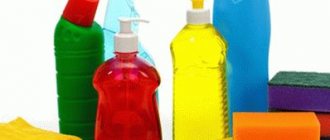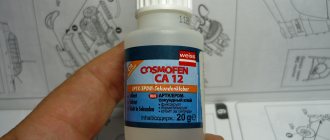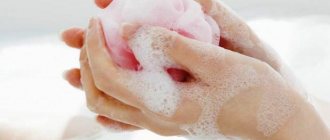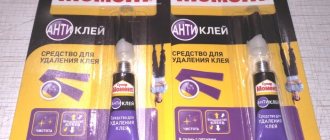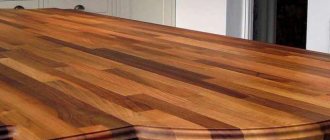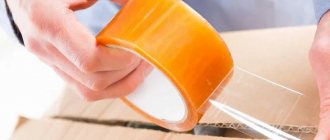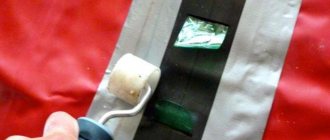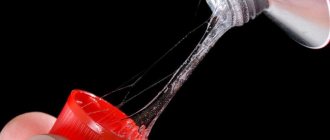Welcome to the “Our Secret” website!
Recently I encountered a problem - how to remove Cosmofen glue? It arose after the box in the “wall” that I bought for a new apartment broke. To seal it, after a series of experiments, Cosmofen became the best remedy.
He glued the box together, and firmly, but bad luck - a few drops leaked and stained the linoleum. It’s not that I glued on a bare floor, but the newspaper I laid on it did not save the floor from a very sticky and then hardened spot of glue, and even with newspaper text printed on it.
How to remove Cosmofen glue from linoleum and plastic, based on my own experience
Welcome to the “Our Secret” website!
Recently I encountered a problem - how to remove Cosmofen glue? It arose after the box in the “wall” that I bought for a new apartment broke. To seal it, after a series of experiments, Cosmofen became the best remedy.
He glued the box together, and firmly, but bad luck - a few drops leaked and stained the linoleum. It’s not that I glued on a bare floor, but the newspaper I laid on it did not save the floor from a very sticky and then hardened spot of glue, and even with newspaper text printed on it.
Mistakes when removing superglue stains
Often, being afraid for the condition of your clothes, you can make mistakes when removing glue stains:
When deciding how to remove superglue from clothes, it is important to analyze all the products that are available at that moment and choose the ideal one according to the type of fabric.
You should act slowly and carefully, remembering that the future type of clothing and the family budget depend on how the cleaning products are used correctly.
In difficult situations, the Internet will always come to the rescue, where there are videos with detailed actions in this situation.
Don't forget to subscribe to our Yandex Zen channel!
Many people believe that getting super glue on a thing irrevocably ruins it. But there are several ways that can help in this situation. It is best, of course, to remove any glue from the surface of clothing before it dries, but you can also deal with dried stains of this product.
Important! Do not rub the glue over the fabric or soak it with cotton pads or swabs, as their fibers will only strengthen the consistency of the substance.
In many cases, any chemical that contains alkalis or fat or caustic compounds will help clear up the misunderstanding.
You can remove superglue from clothes that have not yet dried in the following ways:
For a better effect, you can apply a drop of glycerin or Vaseline to the affected area, since fat is the enemy of superglue.
After this, the product must be washed in soapy water.
If necessary, this procedure should be repeated several times until the dark spot disappears.
How to remove glue from different surfaces?
It is clear that it was necessary to lay something waterproof under the box being repaired, like a piece of old linoleum (by the way, it was left over from a recent renovation). But we are all strong in hindsight, “we would have known where to fall. “And now the problem has arisen in full force - how to remove Cosmofen glue? How to wash Cosmofen glue? How to remove Cosmofen glue from linoleum that has just been laid on a floor that was leveled during renovation? Such thoughts were spinning in my head.
What have I not tried! Solvent, acetone, alcohol wipe, melamine sponge. Nothing helped! The most I achieved was to slightly wash off the top, newspaper layer of the terrible stain. The glue itself stuck tightly to the linoleum and was not going to come off. And no wonder, because this is a special, instantly drying cyanoacrylate super-glue Cosmofen CA 12, and not some stationery, bookbinding or even “Moment” glue.
However, it was necessary to deal with it, and I rushed to the Internet, where I sent a request “how to remove Cosmofen glue.” And I finally found what I was looking for! It turned out that my “favorite” Cosmofen can be washed with only one inexpensive and reliable product - Dimexide medical solution, which is sold in any pharmacy. There would be no happiness. Just a few months ago I treated a sprained arm with this remedy (and, by the way, cured it quite quickly), and some “Dimexide” remained in the home medicine cabinet.
It must be said that it does not smell very pleasant, to put it mildly, but its benefits are undeniable both for health and for cleanliness in the house. In general, I took this “Dimexide”, poured it generously on the stain, and began to wait for the glue to soften, covering the “operation” site with cotton pads.
15 minutes passed, and I excitedly began to scrub the Cosmofen stain off the linoleum. And (lo and behold!) the stain gradually began to disappear from the floor.
Not immediately, in several passes, but I returned the linoleum to its original purity. There is no trace left of Cosmophen! My joy knew no bounds!
Now I know how to remove Cosmofen glue from linoleum, how to remove Cosmofen glue from plastic (I have not experimented with this yet, but experienced craftsmen say that Dimexide can also cope with dried glue residues on plastic, other finishing materials and even clothes ).
And from this whole story I made several conclusions for myself.
- He who seeks will always find, and no matter how insoluble the problem may seem, there will always be a way to deal with it.
- You need to try glue or other unfamiliar material on a small, preferably non-visible surface, so that in case of failure there is a chance to fix everything.
- It is necessary to reliably protect the surfaces near the repair area so that you do not have to clean them from “uninvited” stains.
This is the kind of useful experience I gained from the recent renovation, or rather, the elimination of its consequences.
General information
Glue CA500-200 (Cosmofen SA-12) in original packaging
Superglue may have different names, but in any case it contains cyanoacrylate
. This must be reflected on the label. The substance has a fairly strong odor and is difficult to confuse with anything else.
When it hits the surface of laminate or linoleum, it hardens, turning first into a transparent and then into a whitish coating.
The final hardening of the glue occurs within several hours.
Glue deposits on the laminate surface
Removing such plaque is mechanically problematic,
That's why they use the chemical method.
There are several ways to remove superglue.
The whole question is only about the speed of removal and possible unpleasant consequences for humans.
The simplest way is to use special compounds based on polypropylene carbonate, which is a natural solvent of cyanoacrylate.
The method is good for everyone, except for one thing - polypropylene is toxic (hazard class 1), so its use is not recommended.
Another way is to use regular water.
Methyl cyanoacrylate dissolves in it, although slowly. Complete dissolution of a glue stain several centimeters in diameter occurs in about a day. This method is also unacceptable, since it is impossible to immerse the floor covering in water for such a long period of time - the laminate will simply deteriorate.
Therefore, the third method is used
It uses the drug dimexide
In fact, dimemxide does not dissolve the glue, but it does react with the outer layer of cyanoacrylate.
Spreading over the area of contact between the adhesive and the coating, it destroys the molecular bonds, which leads to the separation of the adhesive from the coating.
Let's consider the sequence of actions that need to be done,
To remove glue stains from laminate or any other flooring:
Action No. 1 Preparation of materials
Cotton pads and dimexide
1
To remove stains from the surface, you will need cotton pads and a certain amount of dimexide.
Dimexide is applied to a cotton pad
2
The cotton pad is ready. Dimexide is applied to a cotton pad. Now you can start removing the glue.
Action No. 2 Pre-treatment
Circular movements with a cotton pad over the entire surface of the adhesive spot
1
First, it is necessary to saturate the adhesive layer on the coating as much as possible with dimexide. This is done by using a cotton pad in a circular motion over the entire surface of the adhesive spot.
The surface should be cleaned of glue and dimexide residues using a rag.
2
Gradually, dimexide will begin to penetrate between the glue and the surface, and the glue stain will partially collapse and fall off. In this case, its fragments will remain on the cotton pad.
Remaining parts of glue
3
In about 1-2 minutes, from 50 to 80% of the glue will be removed, and only the most well-adhered fragments will remain on the surface.
This suggests that dimexide is not enough and it is advisable to saturate the disk with it again.
Action No. 3 Final surface cleaning
Movements with a cotton pad during final cleaning of the surface
Next, you should once again walk over the surface of the coating with a cotton pad.
In this case, the movements should not be circular, but directed along the fibers.
View of the cleaned surface without traces of glue
At this stage, removal of glue residue occurs even faster than at the previous one.
If you liked our article, please like it)
Subscribe to the channel so you don't miss anything interesting!
More photos and video content on the website
https://krrot.net
How to remove “Moment” or “Second” glue?
PS During my manipulations with the floor, my grandmother came to visit us and, having learned what I was doing, complained about a similar problem. The grandson was making something and heavily stained the table with “Moment” (“Second”) glue. She tried to wash it for a very long time using all sorts of means, but it did not give any result. Although the glue was different, I shared Dimexide. And you know, he coped with this trouble very well. After leaving the solution overnight and covering it from drying, my grandmother easily wiped the surface in the morning, removing the dried glue from the table.
Features: pros and cons
Cosmofen brand adhesive has many advantages over other types of adhesive compositions. It has a huge range of applications. The attractive price allows home craftsmen to use Cosmofen everywhere.
Its packaging has a convenient dispenser cap, which allows you to use the adhesive composition very economically. This dispenser is convenient for precise dosing. The minimum temperature at which glue can be used is at least +5 degrees. A reliable cap that closes tightly after use prevents premature drying.
The disadvantage of “Cosmofen” is that the formed adhesive seam softens at a temperature of +80 degrees, and therefore it is not recommended to glue with it those parts that will be operated at high temperatures or have contact with hot objects.
In liquid form, the component ethyl cyanocrylate, which is part of Cosmofen, is toxic and releases harmful substances.
Therefore, when working indoors, they should be well ventilated.
Mechanical methods
Mechanical methods involve the use of a sharpened knife or blade. With their help, the top layer of glue is cut off, after which the surface must be wiped with a washcloth and powder or plain water.
This method will be successful only in cases where the thickness of the glue is significant and the contaminated surface area is large.
Some people use masking tape as a cleaner. It is glued to the desired area of the plastic and torn away from it with force.
This method raises a lot of doubts because it does not guarantee that the problem will be resolved. But there is a possibility of damage to the item.
Heat-resistant surfaces are cleaned using high temperature. To do this, place a container with hot liquid on the damaged area and leave for several minutes. After which the softened glue is scraped off with a knife or wire wool.
Scope of application
"Cosmofen" has a wide range of applications:
- It is used when working with various types of plastic (including PVC and polypropylene surfaces). When installing windows, an adhesive composition is used to connect the sealing profiles. It is not used for gluing porous plastic, since the adhesive composition, when absorbed by the pores, cannot impart the necessary strength to the joint.
- "Cosmofen" is indispensable for plumbing work.
- The adhesive composition is widely used in the production of toys and various jewelry.
- Used in sailing modeling.
- Not a single assembly of radio-electronic and electrical industry products can be completed without Cosmofen.
- Used in the production of optical instruments.
- The adhesive composition works well when working with glass, rubber, and metal.
- Medicine has adequately appreciated the quality of the glue - it is widely used in the production of equipment for orthopedics and dentistry.
- "Cosmofen" is also intended for the installation of suspended ceilings.
- The polymer is applicable in the production of cars, aircraft and ships.
- Used in the woodworking industry to connect wooden products, chipboards, and fiberboards together.
- When Cosmofen is mixed with a primer, a composition is formed that glues products made of silicone and thermoplastic elastomers.
Restrictions on use
Small fragments of Cosmofen are connected instantly. But the glue has a number of restrictions on its use:
- It is not recommended to glue objects that are in constant contact with water;
- The structure of the glued fragments should not be porous;
- Do not use Cosmofen in work where it is necessary to obtain a plastic seam;
- Aluminum surfaces must be coated or specially treated, otherwise the bonding efficiency is significantly reduced;
- The chemical inertness of polypropylene and A-PET can lead to poor joint quality;
- Carefully connect surfaces with different thermal expansion.
Knowing and using the obtained limitations in practice, you can achieve excellent results in gluing the desired surfaces.
Specifications
“Cosmofen” is a one-component adhesive composition based on cyanoacrylate. The glue consists of an active substance that is completely ready for use. There is no need to mix it with other components before work.
The instructions for use provide a clear description of the technical characteristics of the adhesive composition.
The holding time of surfaces glued together is a matter of seconds. The time for final polymerization of surfaces with each other ranges from 6 to 16 hours. It depends on factors such as the temperature at which the gluing process occurs and the structure of the material on which the adhesive composition is exposed.
It should be noted that high air humidity significantly increases the time for final gluing of products.
When the adhesive composition hardens, it forms a uniform transparent film that is completely invisible. All products, after gluing with Cosmofen, are not afraid of environmental influences and sudden temperature fluctuations, and can withstand high temperatures of up to 80 degrees.
The thermal stability of Cosmofen lies in the ability to resist the occurrence of cracks under all possible cyclic temperature changes.
in packages of 20, 500, 200 g.
You can buy glue at various hardware stores.
Cosmofen glue is always available at specialized retail outlets selling radio components.
Mechanical methods
Mechanical methods involve the use of a sharpened knife or blade. With their help, the top layer of glue is cut off, after which the surface must be wiped with a washcloth and powder or plain water.
This method will be successful only in cases where the thickness of the glue is significant and the contaminated surface area is large.
Some people use masking tape as a cleaner. It is glued to the desired area of the plastic and torn away from it with force.
This method raises a lot of doubts because it does not guarantee that the problem will be resolved. But there is a possibility of damage to the item.
Heat-resistant surfaces are cleaned using high temperature. To do this, place a container with hot liquid on the damaged area and leave for several minutes. After which the softened glue is scraped off with a knife or wire wool.
Varieties
Liquid PVC glue “Cosmofen”, in all its technical characteristics, performs the functions of a sealant. It is necessary when finishing the joints of window blocks. Its advantage over conventional sealant is that it does not fade in the sun, does not peel off or change color. This liquid plastic can be used to work with all kinds of polymer coatings when repairing plastic windows, doors, and fittings. It is also used in plumbing work for gluing pipes, gutters, fittings and other things. It is necessary in the manufacture of trade pavilions and billboards.
"Cosmofen CA 12" is a fast-hardening, high-temperature, one-component adhesive. It is very practical and easy to use. They can be used to glue many materials used in everyday life.
How to use?
Before starting the gluing process, the surfaces of the parts to be joined must be cleaned of dust and various fatty substances. Aluminum products are pre-treated with a special solvent or varnished before gluing. The Kosmoplast 10 cleaner is commercially available - this is a solvent cleaning agent used to prepare the surfaces of various materials for gluing. Apply to the surfaces of the parts to be treated with a lint-free cloth. The cleaner is specially made with an antistatic effect.
An adhesive composition is applied to the pre-treated surface of one of the parts to be glued. Application is carried out using a dispenser, which is located on the lid of the container.
Very quickly and firmly, press the parts to be joined together and hold for 10-15 seconds. If the connection is made incorrectly, then further adjustment of the position of objects is impossible. The time for final hardening of the adhesive solution will occur no earlier than 6-16 hours. A characteristic feature of Cosmofen SA 12 glue is that it has a very low viscosity, so if the gaps between the parts to be glued are larger than 0.1 mm, the joining process will not occur. For large gaps, you should purchase other adhesive mixtures. For a faster hardening process, the Cosmoplast catalyst is used.
After purchasing and starting to use, you should carefully study the instructions for using the adhesive composition.
General information
Glue CA500-200 (Cosmofen SA-12) in original packaging
Superglue may have different names, but in any case it contains cyanoacrylate
. This must be reflected on the label. The substance has a fairly strong odor and is difficult to confuse with anything else.
When it hits the surface of laminate or linoleum, it hardens, turning first into a transparent and then into a whitish coating.
The final hardening of the glue occurs within several hours.
Glue deposits on the laminate surface
Removing such plaque is mechanically problematic,
That's why they use the chemical method.
There are several ways to remove superglue.
The whole question is only about the speed of removal and possible unpleasant consequences for humans.
The simplest way is to use special compounds based on polypropylene carbonate, which is a natural solvent of cyanoacrylate.
The method is good for everyone, except for one thing - polypropylene is toxic (hazard class 1), so its use is not recommended.
Another way is to use regular water.
Methyl cyanoacrylate dissolves in it, although slowly. Complete dissolution of a glue stain several centimeters in diameter occurs in about a day. This method is also unacceptable, since it is impossible to immerse the floor covering in water for such a long period of time - the laminate will simply deteriorate.
Therefore, the third method is used
It uses the drug dimexide
In fact, dimemxide does not dissolve the glue, but it does react with the outer layer of cyanoacrylate.
Spreading over the area of contact between the adhesive and the coating, it destroys the molecular bonds, which leads to the separation of the adhesive from the coating.
Let's consider the sequence of actions that need to be done,
To remove glue stains from laminate or any other flooring:
Action No. 1 Preparation of materials
Cotton pads and dimexide
1
To remove stains from the surface, you will need cotton pads and a certain amount of dimexide.
Dimexide is applied to a cotton pad
2
The cotton pad is ready. Dimexide is applied to a cotton pad. Now you can start removing the glue.
Action No. 2 Pre-treatment
Circular movements with a cotton pad over the entire surface of the adhesive spot
1
First, it is necessary to saturate the adhesive layer on the coating as much as possible with dimexide. This is done by using a cotton pad in a circular motion over the entire surface of the adhesive spot.
The surface should be cleaned of glue and dimexide residues using a rag.
2
Gradually, dimexide will begin to penetrate between the glue and the surface, and the glue stain will partially collapse and fall off. In this case, its fragments will remain on the cotton pad.
Remaining parts of glue
3
In about 1-2 minutes, from 50 to 80% of the glue will be removed, and only the most well-adhered fragments will remain on the surface.
This suggests that dimexide is not enough and it is advisable to saturate the disk with it again.
Action No. 3 Final surface cleaning
Movements with a cotton pad during final cleaning of the surface
Next, you should once again walk over the surface of the coating with a cotton pad.
In this case, the movements should not be circular, but directed along the fibers.
View of the cleaned surface without traces of glue
At this stage, removal of glue residue occurs even faster than at the previous one.
If you liked our article, please like it)
Subscribe to the channel so you don't miss anything interesting!
More photos and video content on the website
https://krrot.net
What to scrub with?
Excess applied adhesive in places not intended for gluing should be removed using a special cleaner “Cosmo CL-300.150”.
Removal can also be done with the well-tested Dimexide product. A pharmaceutical product should be poured onto the glue-stained surface to help dissolve Cosmofen. You just need to wait a few minutes. Under the influence of Dimexide, the unnecessary glue will soften. Now it can be easily removed with a napkin or a piece of cotton wool. If you accidentally spilled a large amount of Cosmofen, then this soaking procedure must be repeated several times. “Dimexide” is an excellent product that will never spoil the outer surface of the processed materials or clothing. It will remove all glue completely without any residue.
In order to wash the adhesive off your hands, you need to dilute Dimexide with water.
In concentrated form, it can cause severe burns, so it must be used with great caution.
Universal compositions for removing adhesive traces at home
Regardless of the type of glue, there are universal products that can handle any stain. These include:
- Plain water. It can dissolve almost any glue if you act quickly. With its help you can get rid of stationery, latex, vegetable, carpentry, wallpaper and PVA glue. The principle of removal is simple: the stained area is washed until there are no stains left on it.
- Alcohol. It handles most adhesives. Alcohol dissolves even those glue molecules that have managed to firmly adhere to the surface. It is applied to cotton wool or a sponge, which is used to wipe the stain until it disappears completely. If necessary, the material can be left on the stain in the form of a compress.
- Acetone. It is one of the popular solvents, as it can handle even difficult stains. To remove the adhesive composition, soak a cotton pad in acetone and use it to treat the surface until completely clean.
- Vegetable oil. The fat base makes the glue more pliable and makes it easier to remove it from the surface. To clean, use a cotton pad soaked in oil and rub the stain until it disappears completely. If the glue is persistent, then you will need to make some effort, but the oil can deal with sticker marks in no time.
- Solvents: gasoline, white spirit, turpentine, solvent 646, R-4, RS-2, etc. These caustic compounds allow you to remove different types of glue without a trace. They are used to combat stubborn stains, for example, from silicate glue, Titanium, liquid nails and more.
Alcohol, vegetable oils and water are safe adhesive removers and can be used on most materials.
Acetone and solvents are used with caution, as they can damage some surfaces, such as upholstery or paper.
Specifications
Cosmofen glue is a not very viscous liquid, transparent one-component substance that is used to connect various surfaces. It contains ethyl cyanite acrylate, due to which the parts quickly and firmly stick together, and the seams become colorless after crystallization.
Cosmofen has a very high viscosity index . According to Brockfield, the viscosity is 70 mPa, so after applying the adhesive, the surfaces set in a very short time. Depending on the material of the elements, their setting time can range from three to fifteen seconds.
It is recommended to use the adhesive at a temperature not lower than +5 degrees. At an average temperature of +20 degrees, the surfaces will completely stick together in 16 hours. The time can be increased if there is high air humidity in the room where the gluing work was carried out.
Due to its composition and characteristics, Cosmofen has special properties:
- instantly glues;
- fixes;
- does not contain solvents;
- has good adhesion to various surfaces;
- quickly achieves functional strength during installation work;
- has high heat resistance and cold resistance;
- has good UV resistance;
- characterized by a short hardening time;
- forms a rigid adhesive seam;
- spreads well over bonded surfaces.
Aggressive means
It is necessary to use aggressive substances for cleaning with extreme caution, because... they can ruin the thing completely.
The most effective of them include:
Before using one of the above products, it is recommended to test on a small, inconspicuous place and only then begin work.
“Moment” and “Second” glues are considered especially durable. Therefore, the question most often arises is how to remove glue from plastic.
In this case, experts advise using anti-adhesive from the same manufacturer, because it contains exactly those components that can remove traces of the adhesive in full.
An alternative is dimexide, which can be easily purchased at any pharmacy.
Areas of use
Cosmofen provides a rigid connection to surfaces made of metal, MDF, leather, and plastic. That is why it has a wide range of applications:
- production of toys;
- production of optics;
- jewelry industry;
- technical needs of industry and construction of metal structures;
- orthopedics, dental and medical technology;
- leather and footwear industry;
- processing of rubber, elastomers, plastics;
- production of household equipment;
- shipbuilding and automotive industry;
- EPDM sealing on display cases, facades, windows;
- electronic and electrical industry;
- sealing technology;
- sewerage technology;
- exhibition industry;
- advertising industry and technology.
Cosmofen's instructions
Cosmofen glue should be applied only to previously cleaned surfaces . To clean parts from dirt, grease and dust, it is recommended to use special products - Cosmofen 10 or Cosmofen 60. The treated surfaces should be dried and glue should be applied to one of them directly from the tube. If the adhesive is poured into large containers, you can use special dispensers. The surfaces must be immediately connected and placed under a press until the composition dries completely.
If plastic products will be glued together, they should first be tested for resistance to Cosmofen. To do this, the adhesive is spread on a small area of the part.
It is recommended to store Cosmofen in its original container at a temperature not lower than +5.
Universal compositions for removing adhesive traces at home
Regardless of the type of glue, there are universal products that can handle any stain. These include:
- Plain water. It can dissolve almost any glue if you act quickly. With its help you can get rid of stationery, latex, vegetable, carpentry, wallpaper and PVA glue. The principle of removal is simple: the stained area is washed until there are no stains left on it.
- Alcohol. It handles most adhesives. Alcohol dissolves even those glue molecules that have managed to firmly adhere to the surface. It is applied to cotton wool or a sponge, which is used to wipe the stain until it disappears completely. If necessary, the material can be left on the stain in the form of a compress.
- Acetone. It is one of the popular solvents, as it can handle even difficult stains. To remove the adhesive composition, soak a cotton pad in acetone and use it to treat the surface until completely clean.
- Vegetable oil. The fat base makes the glue more pliable and makes it easier to remove it from the surface. To clean, use a cotton pad soaked in oil and rub the stain until it disappears completely. If the glue is persistent, then you will need to make some effort, but the oil can deal with sticker marks in no time.
- Solvents: gasoline, white spirit, turpentine, solvent 646, R-4, RS-2, etc. These caustic compounds allow you to remove different types of glue without a trace. They are used to combat stubborn stains, for example, from silicate glue, Titanium, liquid nails and more.
Alcohol, vegetable oils and water are safe adhesive removers and can be used on most materials.
Acetone and solvents are used with caution, as they can damage some surfaces, such as upholstery or paper.
Advantages and disadvantages
Cosmofen glue is widely used at home and in industry because it has many advantages:
- Practical, easy to use and economical. A few grams of adhesive is enough to glue parts together.
- After removing rust and degreasing, it can effectively glue metal elements together.
- The maximum strength of Cosmofen is achieved after 16 hours, while other types of adhesives completely harden only after 24 hours.
- Treated surfaces set in literally 5 seconds.
- You can apply the glue directly from the tube, without a brush, spatula or other equipment.
- Small bottles with the composition allow you to have Cosmofen with you and use it as needed.
Disadvantages of Cosmofen:
- It is not recommended to use for gluing parts that will be in constant contact with water;
- Do not glue products that are exposed to high temperatures;
- elements with a porous structure will not have sufficient strength after gluing with Cosmofen.
Wash, remove
When working with various adhesives, you need to be prepared for anything. That is why it is best to purchase a special glue solvent when purchasing the glue itself, so that unexpected stains can be quickly and easily removed. However, if you did not do this, and trouble happened, the information below is for you.
PVA, construction, installation, titanium from clothing
When performing various manipulations with these types of adhesives, you must be prepared for the fact that very often unpleasant situations arise when drops end up on the fabric of your clothes. In such a situation, you should not panic, because there are many ways and means to effectively remove glue from fabric.
The newly placed adhesive patch is very easy to work with.
It is enough just to wash it off the surface of the fabric with warm water and a rag, and then thoroughly rub the damaged area with a soft brush. Dried PVA is somewhat more difficult to remove, but it is possible.
This is done with vinegar. You need to moisten a cotton swab in this product and wipe the stain thoroughly. After some time, the glue will come away from the fabric in a thin film. The area where the glue was located must be carefully washed with warm water and soap.
The method of application is completely simple: you need to soak a cotton swab in one of the described products, and then carefully wipe away the glue stain.
At the end of the procedure, the damaged area should be thoroughly wiped with a soapy sponge.
Among other things, it should be noted that PVA glue comes away from the fabric at a temperature of about minus 15 degrees.
Therefore, if your freezer is capable of achieving this indicator, you can place the spoiled product in it. After 10-15 minutes, you can take out and start the washing machine.
To remove liquid nails from clothes, you will need:
The type of solvent required is usually indicated on the adhesive packaging. In some cases, they are included, which makes the task much easier. In order to remove acrylic glue, just rub it with warm water and soap, and then carefully go over it with napkins. It is much more difficult with neoprene solutions, because here you will have to work quite hard, and there is no guarantee that the fabric will return to its original form.
Here you will have to use a specially designed solvent. Please note that it can damage the structure of the fabric, as well as the color.
If you don't have solvent on hand, you can try soaking the glue stain in acetone.
Baby cream or Vaseline are necessary for careful removal of glue, as they soften the dried composition, which allows you to carefully remove it from clothing.
Superglue "Titan" is also a very difficult product to remove. First of all, you should use all the methods described earlier, however, if this does not help, you will have to resort to extreme measures:
How can you wipe off cosmofen, silicone?
Quite often, special glue “Cosmofen” is used to install suspended ceilings, as well as window slopes. If during construction work or at the end of it you notice that linoleum, the ceiling or your clothes are stained with this product, you should know one thing - you can remove it with a good and cheap drug called “Dimexide”.
You can purchase it at absolutely any pharmacy in your city at an affordable price.
In order to remove the remains of dried Cosmofen from a hard surface, you just need to generously pour Dimexide onto the stain and wait until it softens.
Softened residues can be removed with a cotton pad or napkin.
If you suddenly spill a lot of glue, the procedure described above will have to be repeated several times.
You don’t have to worry about the safety of the product, since Dimexide leaves absolutely no traces and is an environmentally friendly drug.
To remove silicone glue, it is best to purchase a special solvent. Silicone can be carefully scraped off hard surfaces, then removed with warm soapy water.
You can use the method using a vinegar solution.
After removing the self-adhesive film
Among other things, you should know how to remove it correctly:
